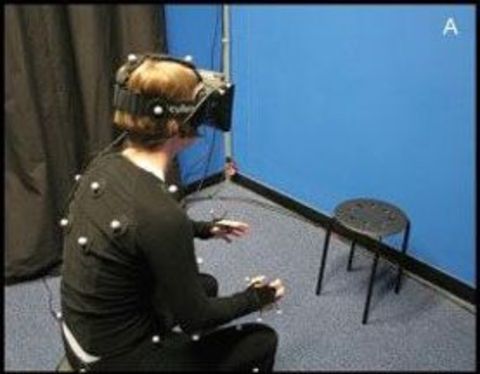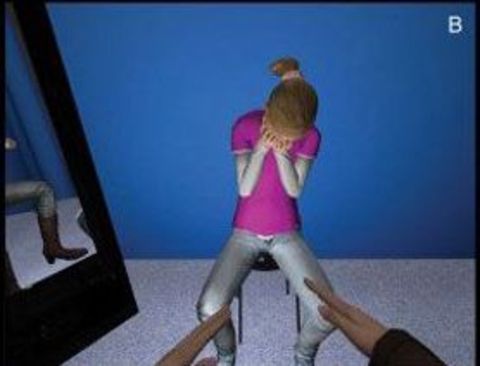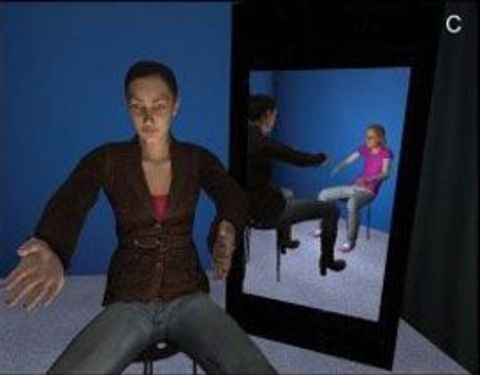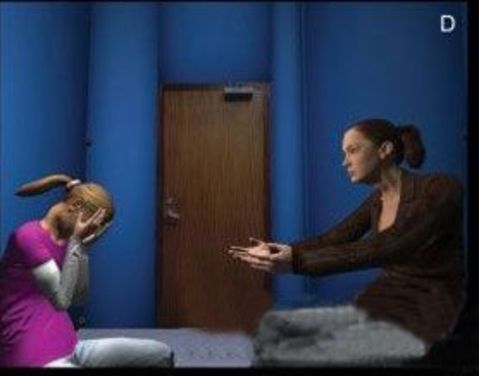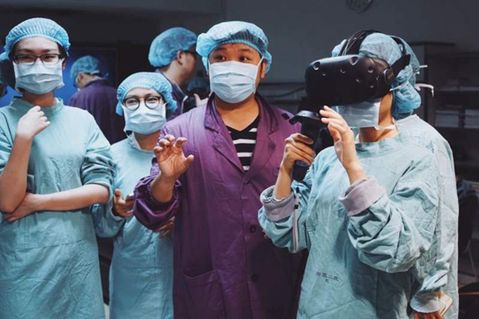Medical is the biggest market for VR: the application of psychotherapy may be unlimited
It is understood that the medical department first used VR technology to treat social phobia. In a social scenario designed for the patient, by observing the patient's response, the psychologist in the background can choose to increase or decrease the treatment level instantly. Experts say that it takes at least a decade for a surgeon to stand on the operating table, and VR live teaching is expected to shorten this time in the future. 2016 is called the first year of virtual reality. When VR collides with medical treatment, what sparks will it produce? "Game and film are driving the development of VR (virtual reality) technology, but medical care will be the largest market for VR." Walter Greenleaf, director of the Stanford VR Medical Research Institute, visited China in mid-July. In a public speech in Shanghai, I said. Greenleaf is one of the global pioneers in applying virtual reality technology to healthcare. He has been researching VR technology for more than 30 years. In his view, the combination of VR and medical treatment can be achieved in four aspects: medical intervention, clinical diagnosis, medical training, health care. According to a research report on virtual reality medical services market released by research institute RnR Market Research, the global VR medical service market will grow at a compound growth rate of 19.37% from 2014 to 2019. Although the application of VR in the medical field began in Europe and the United States, domestic startups and technology companies are actively deploying. 1VR is especially suitable for the treatment of mental illness “The new VR technology is increasingly infiltrating into medical care, especially for the psychiatric field.†Xu Yifeng, dean of the Shanghai Mental Health Center, said that “the psychiatric department is mostly reflected in other problems such as brain thinking and emotions. These are difficult to reproduce in real scenes, and it is easier to use VR to train patients or treat brain emotions." It is understood that the Shanghai Mental Health Center has reached an agreement with Shanghai eDoctor Wing Information Co., Ltd., the two sides will first cooperate to study the use of VR technology to treat social phobia. The expert team of the Shanghai Mental Health Center will provide professional medical advice from the perspectives of project design and intervention scene design, while Wing is responsible for the software and hardware development required for VR technology. Xu Yifeng introduced that the previous methods of treating social anxiety disorders were mainly psychotherapy and drug treatment. The overall therapeutic goal is to control and alleviate social anxiety-related anxiety syndromes, reduce fear avoidance behavior, improve patients' social function, and improve quality of life. "In the past, when we were treating, we needed patients to imagine a lot of scenes. This method is very subjective, there is a lot of uncertainty, and the treatment effect varies from person to person." Xu Yifeng said, but now patients only wear VR glasses. You can enter the virtual scene set by the doctor and get immersive. Huang Yingfeng, the founder of Wing Duo, said that the biggest difficulty in using VR to treat social phobia in the short term is the part of the software, that is, the design of the treatment scene. "The data of the curative effect is digitized by standardized psychotherapy. If it can be proved that the evaluation effect is effective, The output will be faster than expected." “We have designed a variety of social situations for patients, and the pressure on these scenarios is gradually increasing. In certain scenarios, patients will be required to complete the assigned tasks.†Wing Multi Company Partner, Strategic Market Director Zhang Wei said, “For example, in the introduction of the design, the patient will be in a cafe, he will be asked to see a strange customer to submit a document, this is a simple one-on-one scene. Then slowly Transition to a one-to-many, many-to-many complex scenario. By observing the patient's response, the psychologist in the background can choose to instantly enhance or reduce the treatment level." "The application of VR in psychiatric treatment may be unlimited." Xu Yifeng said, "After this project is completed, we will try on other mental illnesses." Currently, VR is also used to treat veterans abroad. Veteran traumatic sequelae, phantom limb pain in children with disabilities, children with ADHD, autism, etc., even have an effect on improving acrophobia and claustrophobia. 2VR+AR allows doctors to watch movies on the "hand" Virtual reality technology determines its application scenarios and images, and is closely related to visual images, thus allowing medical imaging equipment companies to see the value. “As early as three years ago, we started to work in the field of VR/AR. The most notable feature of VR technology is its immersion, interactivity and conception, giving the operator an intuitive and authentic experience. This is exactly what the medical imaging field hopes to be able to Brought to the doctor." Wang Shuai, senior director of image processing R&D, Software Division, Shanghai Lianying Medical Technology Co., Ltd. "So for medical image processing software, we have been thinking about whether we can use VR, AR (Augmented Reality) technology to provide a simple interactive way for doctors to observe the lesion structure, thereby improving the diagnostic efficiency and reducing the rate of misdiagnosis." Wang Shuai said . This year, Lian Ying launched a medical device that combines VR and AR technology to help doctors visually and dynamically observe the structure and changes of anatomical tissues in a 4D image. In other words, after the doctor diagnoses the patient, he will no longer see a planar two-dimensional film, but a three-dimensional dynamic image, and the diagnostic accuracy will be greatly improved. The Morning Post reporter experienced this technology on the spot: wearing special VR glasses, the three-dimensional image of the heart on the computer screen suddenly appeared in the reporter's palm. With the slow rotation of the gesture, a beating heart rotates on the hand. Get up, you can get 360 degrees close to your eyes. "VR technology can only bring practical value to doctors and patients by combining very specific clinical scenarios and truly solving clinical problems." Wang Shuai said that this technology provides doctors with a true 4D full-view, continuous MPR. (Multi-planar reconstruction) observation method, by means of simple interaction, simulates the way of observing objects in real space, allowing doctors to freely observe the lesion structure from any angle. Wang Shuai said that with the development of technology, medical images gradually transition from the traditional 2D era to 3D, 4D, and even 5D is the development of the industry. The application in the field of medical software not only relies on the development of VR and AR technology itself, but actually relies more on medical device imaging technology, advanced medical image processing technology, medical image visualization technology, medical information technology, machine learning technology, computational aided diagnosis technology, Deep accumulation and talent reserve in many aspects such as clinical diagnosis. 3 eye tracker to help "freeze people" online The eye tracker is a computer-connected device that locates the human eye by the principle of near-infrared reflection, detecting and recording the position of the pupil of the eye. "In the world of the Internet, no one knows that I am a frozen person who has been stunned for more than ten years." Zhang Ming (a pseudonym), a motor neuron patient who lives in Zibo, Shandong, is shot on the computer screen in front of him by eye tracker. One line of words. Motor neuron disease, also known as amyotrophic lateral sclerosis, is also known as the "gradual frozen person". After getting sick, the muscles of the patient's limbs, trunk, chest and abdomen will gradually become weak and atrophy. After further deterioration, the language ability will be lost. Only the brain and eyes can move autonomously. Before using the eye tracker, Zhang Ming’s daily life was lying in bed, waiting for his family to cook his three meals and living. "The days are the same as waiting for death," Zhang Ming said. Before he was sick, he was a staff member of the Zibo City Disabled Persons' Federation. He learned the eye tracker device through the Disabled Persons' Federation last year. The eye tracker is a computer-connected device that looks like a home set-top box. It locates the human eye through the principle of near-infrared reflection, detects and records the position of the pupil of the eye, and replaces the traditional human-computer interaction such as touch and click. Now Zhang Ming is sitting in front of a computer equipped with an eye tracker, surfing the Internet through eyes, chatting on WeChat, reading e-books, playing games, etc. It is also possible to control the switch of home appliances through smart home software - switch lights, pull Curtains, switch fans, etc. can all be done through the eye-operated computer page, no need for family assistance. The eye tracker used by Zhang Ming was developed by Shanghai Qingyan Information Technology Co., Ltd. The general manager of the company, Du Fu, told the Morning Post reporter that the core technology used by the eye tracker is eye tracking. The company initially customized the eye tracking module needed for virtual reality hardware manufacturers such as VR helmets and VR glasses. Later, the company believed that this technology was independent and could play a greater social role and improve the quality of life of people with reduced mobility. So it launched the eye tracker. “Strictly speaking, interoperability with eye movements is not a VR technology itself, but an integral part of the technology required for VR hardware,†explains the staff at Qingyan. "When the body gradually becomes unable to move, the brain is still awake. Because it can't be communicated, the family does not know the patient's needs. Many people who are gradually frozen feel that it is meaningless to live, and they are mentally tortured. Use eye movements. Instrumentation, gradually frozen people can communicate with others through typing on the Internet. For the family, it also reduces the burden and reduces the cost of care. It can be said that both social value and economic value." Du Fu said. 4VR live teaching: immersive observation of top expert surgery Zhang Wei had 8 years of experience in ophthalmology clinicians. In his view, the two areas that VR+ medical treatment is the easiest to achieve, except for psychiatry, are surgery, but not for surgery. It is doctor training. “Medical graduates or young doctors must go through hundreds of operations before they can go to the operating table. In the past, due to limited space, only a small number of people in a surgery can learn from the side, and it is not even clear. Zhang Wei said. On July 5th, the operating room of the Eye Center of the Second Hospital of Zhejiang University School of Medicine was crowded. Many ophthalmology graduates and doctors experienced a live VR episode of eye surgery. In this operation, Professor Yao Ke, the top eye surgery specialist in China, and his team were working. A participant who participated in the live broadcast of the operation said that the accuracy of the medical operation is between the points. The angle, strength and measurement of the surgeon's knife must be taken very carefully. In particular, eye surgery is viewed through a 2D display, and the real experience is general, and the learning effect is not satisfactory. But VR live teaching can give people a sense of immersiveness. And it is also free from space constraints, so that doctors from all over the country have the opportunity to observe the top specialist surgery. "The current VR surgery live in the surgical field is only 3D, which allows the students to get a sense of participation only on the screen. In the future, we also want to achieve 4D surgery through technical means, through the contact or tremor of the device can make the viewer feel The doctor’s change in the strength of the knife, which was previously unimaginable.†Zhang Wei told the Morning Post reporter. Qin Xinyu, a medical expert and former party secretary of Shanghai Zhongshan Hospital, said that it would take at least a decade for a surgeon to stand on the operating table, and VR live teaching is expected to shorten this time in the future. In addition to being used for doctor training, many VR surgery live broadcasts have also begun to invite patients' families or even patients to watch together. The purpose is to change the preoperative explanation mode traditionally drawn by paper and pen through an intuitive surgical procedure, to enhance the understanding of both doctors and patients, and to reduce the contradiction between doctors and patients. The Morning Post reporter also learned from the wing that the company has another set of VR software for doctors. It can help medical students become familiar with the muscle tissue, nerves, blood vessels, bones and other structures of the human body. When the student uses the VR handle to point to an organ in the human body, it can be separated and observed at close range. When the student lifts the handle close enough, he can enter the inside of the human organ at once, and can see the internal structure and operation of the brain and blood vessels. Goldman Sachs said in a VR research report released earlier this year that the number of doctors using VR and AR devices is relatively small compared to the consumer market. The bigger market opportunity lies in the specific software, not the hardware being sold. For architects and engineers, CAD software ranges from $1,000 to $5,000 per year. In contrast, based on the $1,500 software subscription cost, it is estimated that 800,000 doctors and EMT (emergency medical ambulance technicians) will use VR and AR technology in 2020, and will reach 3.4 million in 2025. - Morning Post trainee reporter Bao Yuqi Intern at the bungee
Stainless Steel Bottles are made from high-grade 18/8 stainless steel. This material is food grade, non-toxic, durable and easy to clean.
And we got a lot of different kinds of Stainless Steel Bottles. For example: Stainless Steel Cola Bottle, a classic design that is popular in the market and easy to use, also looks good. Speaking of looking, our Cola Bottle comes in changeable colors and diverse patterns.
Stainless Steel Cola Bottle,Stainless Steel Vacuum Cola Bottle,Stainless Steel Silk Printing Bottle,Stainless Steel Rubber Printing Bottle Ningbo Auland International Co.,Ltd. , https://www.sellerbottle.com